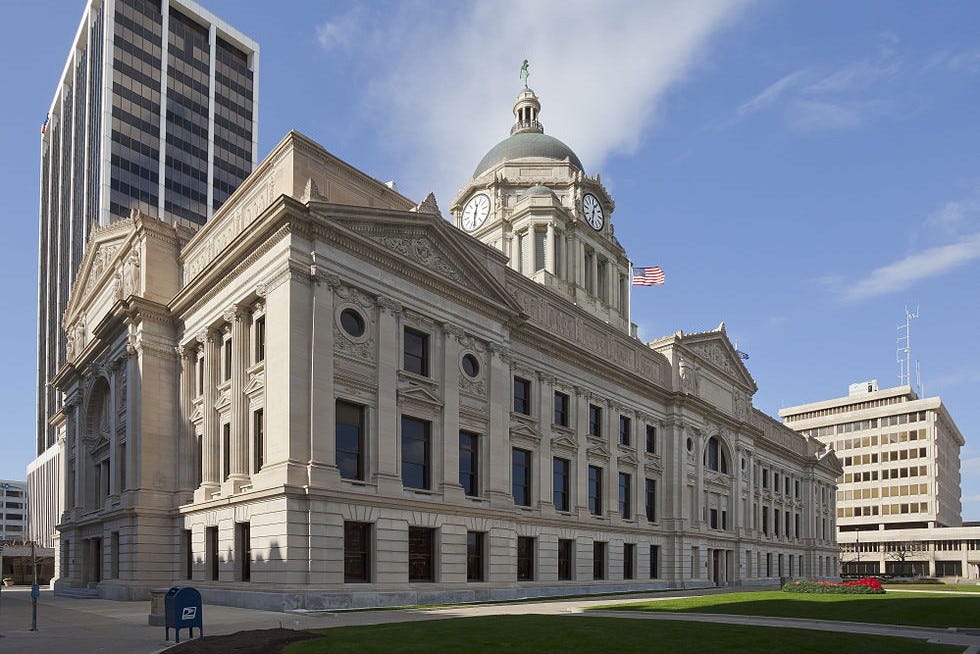To replace lost revenues, Allen County Commissioners face approving new projects like solar farm or raise local taxes
Commissioners Therese Brown and Ronald Turpin likely deciding votes on whether solar farm is approved
Senate Bill 1 would provide property tax relief for Indiana residents, but it also would increase the pressure on local governments to replace lost public funds for schools and infrastructure through other means such as economic growth.
Local governments such as Allen County will need to find other sources of revenue – either through increased taxes or more economic activity in the county – to contribute to the tax base.
Allen County is at a decision point on this very issue as it weighs approval of Flatrock Creek Solar Park, a solar power farm that could bring millions of new revenue into the county coffers.
“Senate Bill 1 fundamentally reshapes local fiscal responsibility,” said Dan Hennessey, president of Indiana-based Hennessey Consulting. “It effectively puts elected officials at a crossroads: either approve targeted tax increases or foster strategic development projects to meet budget needs.
“It’s a shift that encourages communities to balance taxpayer protections with proactive growth — empowering leaders to choose how they fund essential services.”
Flatrock Creek Solar Park could help that.
“The assessed value of [the project] positively impacts the tax impact of everyone in the county,” said Trena Roudebush of EDP Renewables North America. “There is greater benefit closer to the project site – specifically the taxing units such as East Allen Schools, the township, local library, etc.”
SB1 is intended to ease property tax burdens on homeowners, businesses and farmers. Among its provisions is that, beginning in July 2027, county fiscal bodies will be the adopting bodies for their respective county local income tax (LIT) rate.
The Allen County Board of Commissioners already has dealt with the prospect of increased LIT rates. For example, in October 2023, the Allen County Council voted to implement a Correctional or Rehabilitation Facilities LIT to fund construction of a new county jail.
Allen County Commissioners, including current Commissioner Therese Brown, subsequently criticized the council for what was deemed an insufficient LIT rate and warned that a possible ensuing budget shortfall could result in the commission asking for an LIT rate increase.
Reduced property tax revenue as a result of SB1 also will reduce taxpayer funds for public schools. Moreover, SB1 requires that, beginning in 2028, public schools must share revenue from their operations fund levy with certain charter schools, leading to further funding cuts to public schools.
Public school officials have raised concerns about these funding cuts driven by SB1. As WBOI reported, Northwest Allen County Schools Superintendent Wayne Barker testified in March that SB1 could prevent that school system from pursuing a planned operations referendum.
In a letter, Fort Wayne Community Schools Superintendent Mark Daniel had written that SB1 could pull $12.5 million from his system over a three-year period. WFYI reported that Indiana Public Schools had estimated that, between 2026 and 2032, SB1 could result in over $96 million in lost revenue for public schools in the state.
Allen County is experiencing significant population growth, which brings a greater need for supportive infrastructure. As NewsLine Local previously reported, the current Allen County zoning ordinance dictates that in unincorporated areas, solar project developers cannot install a Commercial Solar Energy system within 400 feet of a property line, making installation of projects such as the Flatrock Creek Solar Park more difficult.
To meet growing energy demands as well as the demands of a growing population, the Allen County Commission likely will need to adopt more workable ordinances or be faced with making difficult decisions about tax increases, which would be unpopular with constituents.
Relaxing the zoning ordinance would allow the Flatrock Creek Solar Park project to proceed, setting the stage for increased tax revenue to offset SB1’s decrease in property taxes.
According to the project’s factsheet, the solar park would generate an estimated $30 million in tax revenue for the local government – including more than $16 million for local schools – during the project's lifetime as well as $40 million for local landowners. That money could in turn be reinvested into the local community.
According to Per Greater Fort Wayne Inc., Allen County Commissioners Brown, Rich Beck and Nelson Peters wrote in a joint statement that, as population growth creates greater potential for job opportunities, economic expansion, and higher per-capita income, “the Board of Commissioners recognizes there are growing pains as well. For this reason, county government will continue to make strategic decisions regarding roadwork, bridgework, and other infrastructure improvements.”
With SB1 putting increased pressure on local governments to find ways to generate the revenue needed to maintain infrastructure and provide for residents’ needs, the Allen County Board of Commissioners, including Peters’ successor Ronald Turpin, faces the prospect of LIT rate increases.
The Board of Commissioners also can encourage and approve development projects that will enrich the local economy and help fulfill the county’s fiscal obligations.



